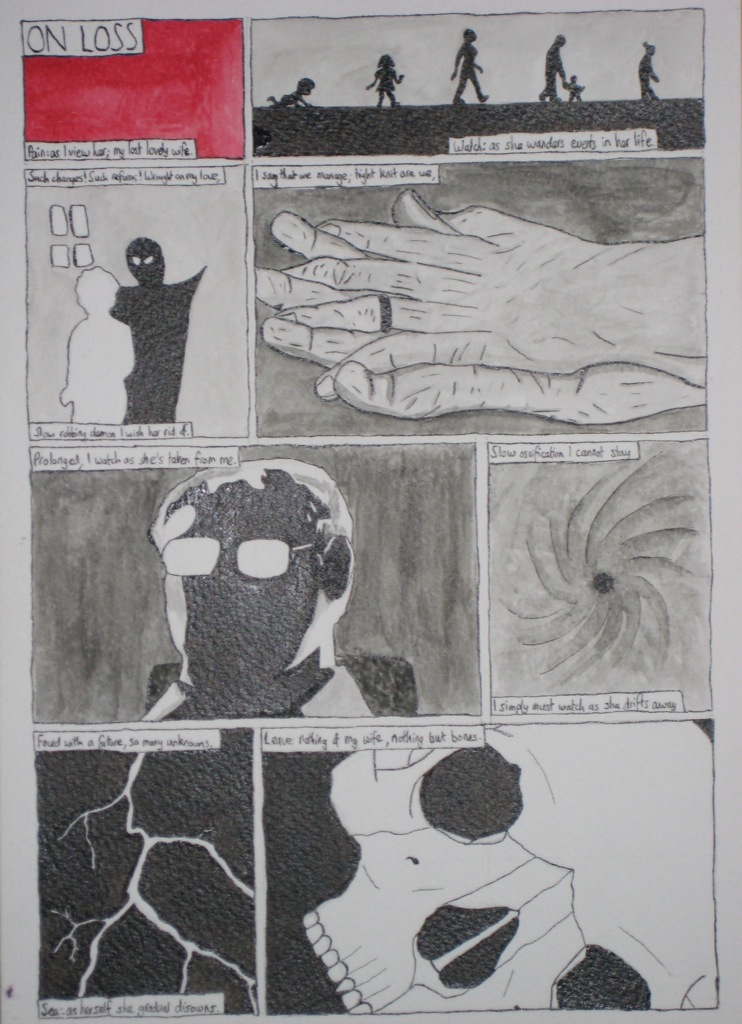Anti Mnemonist
The first view was from the patient herself, an elderly married woman who had developed dementia. She did not volunteer huge volumes of information, but I tried to use what she said to develop this piece. I started thinking about major images that developed, primarily the picture of an old piano and the formation and travel of a tear drop. These related to themes I wanted to put across; confusion (especially with time) that the condition creates, as well as the frustration and sadness it brings. The piano image was one brought up several times and was an image from her childhood that she kept referring to. Childhood memories were particularly strong in her despite deterioration of recent memories, and I got a strange sense of intercalation from her, as old memories were recycled and reused. The text I wrote in the form of a sonnet and I attempted to convey the major feelings of temporal confusion and frustration in it. A sonnet was chosen as it provides a slightly ethereal quality which I thought matched what living with the incoherent memories dementia brings may be like. The first two images in the present I drew in cartoonish fashion to indicate the frailty and lack of consistency in her present. The images of the past were coloured in sepia to indicate the antiquity of these memories and the space outside of the window and door was shaded black to indicate its disjointed nature in time. The slow opening of her eye into the present once more, and the formation and passage of the tear were to provide striking final images that hopefully convey the sadness and frustration to the reader that the patient discussed.
The second view was from that of the patient’s carer, her husband. Her husband provided an honest picture of the condition and the changes it had brought about in his wife. He stated firmly that the dementia had changed her and that she was no longer the woman he married; hence this piece’s title, ‘On Loss.’ I believed he was focused on the changes diagnosis had brought and I sensed he missed the woman his wife had been. The text was written in heroic couplets. This was done to provide a poetic outlet that complemented the text of his wife and reflected their intimacy as a couple. The art in this page is of a much darker tone, and the predominance of greys and blacks reflect the bleaker nature of his outlook for the future, and his fears of his ability to look after his wife in the years ahead. Although not fully developed here, the name of the demon standing behind his wife was intended to be ‘Prognosis.’ This was to reflect the way in which the awareness of the progression of the condition shadowed their life. The deep shadow of the ‘demon’ contrasted with the brilliant white of his wife’s silhouette and was done to express the fading away of her old self but the remnants of the pure unsullied memory of her as she was. The stark picture of his silhouette was my favourite of the drawings; the white of his glasses emphasising the text it accompanies and reinforcing the inherent worry. The final image of the anatomically correct skull and its text has several layers of meaning, and the austere white of the skull provides a harsh contrast against the black of the background. The most superficial meaning signifies the impending mortality that will occur, but on a more symbolic level, represents the decline of his wife into being mere ‘bones’ of the woman he loves.
The final view was a more clinical ‘medical’ view and in this I wished to extend information about the pathology and causes of the disease. The text for this was written in prose to reflect its scientific content. Many of the images I tried to make as diagrammatical as possible, to reflect on the clinical aspects.
*details changed to maintain patient-confidentiality



0 Comments